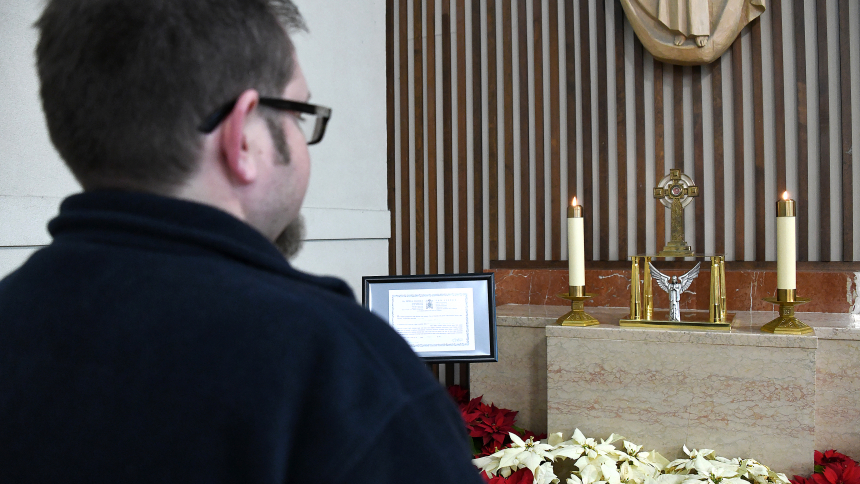
HAMMOND – When Father Jeffrey Burton was appointed administrator of St. John Bosco church, he began a process of getting to know the people of his parish. He next familiarized himself with the surroundings the church, school and many sacred objects.
Father Burton, who arrived at the Hammond parish in July, said he soon found holy objects that had been set in closets, drawers and other storage spaces. Dusty reliquaries and tarnished chalices deserved better placement, and the four-year priest said he had a plan to enhance St. John Bosco’s worship space.
“This was a hard-working parish that always had two or three priests,” he explained. “‘Father X’ likes this, and ‘Father Y’ likes this, so this is what we’re going to use. With every priest, the other priest's favorite vessels got pushed to the back of the cabinet.”
The ultimate goal is to create a space most suitable for prayer and worship.
“We want to provide a prayerful atmosphere; this is a house of praise and worship to God,” Father Burton said.
Father Burton credits the assistance of Deacon Matthew Virus, who was recently assigned to assist at St. John Bosco, for the uncovering of many sacred items around the parish buildings.
“Deacon Matt and I have been cleaning everything out and discovering treasures of our tradition here,” Father Burton explained.
Of particular interest to Father Burton was the discovery of a first-class relic of the parish’s namesake. The bone fragment of St. John Bosco is encased behind glass and includes a certificate of authenticity.
A first-class relic is an actual piece of a saint’s body – hair, flesh or bone. Mentioned as objects of veneration and a cause for pilgrimages since the second century Anno Domini, relics of saints and instruments of the Lord’s passion have been enshrined in altar stones, cathedral crypts and displayed in reliquaries.
St. John Bosco was an Italian priest, writer and youth advocate, who passed away in 1888 at age 72 in Turin, Italy.
According to St. Helen Associate Pastor Father Frank Torres, who said he was known for years as the diocesan “scavenger” of sacramentals and holy objects, many such items have been reclaimed, especially those that were transferred to new homes from parishes that were closed.
Father Torres was the Diocese of Gary’s official inventory specialist until about six years ago, when Father Ted Mauch, administrator of Holy Martyrs combined parish in Merrillville, took over that responsibility.
Echoing Father Burton’s thoughts, Father Torres said pilgrimages and tours where relics and other sacred objects are preserved is a way for Catholics and other Christians to connect with holy men and women who have gone before us.
Father Torres said for those not understanding of the veneration of relics and sacred items, he compared the fanfare to that commonly associated with sports and entertainment events.
“We save our admission tickets, we save our programs, and all kinds of memorabilia,” Father Torres said. “We keep that stuff and share it with people of common interest. When it comes to our faith, we have these precious relics of the saints, the heroes of our faith that we collect and tell their stories.”
Father Torres said the popularity of relic pilgrimages survived through the Middle Ages, Renaissance, Protestant Reformation and into recent centuries. He pointed to Germany’s Cologne Cathedral (officially, Hohe Domkirche Sankt Petrus) as one of his favorite sites for such touring.
The 515-feet tall Gothic Catholic church contains priceless art, stained glass and relics of the scriptural Magi, housed in the Shrine of the Three Kings. It is the most visited site in Germany.
At St. John Bosco, Father Burton set out to create a prayerful area for the faithful to view the St. John Bosco relic. He cleared a marble ledge below a wood carving of the Holy Family, where the newly polished reliquary was set. At the side altar, candle stands frame the sacred display, and a padded kneeler was placed nearby.
After daily morning Mass, Sally Feere said that she believes the refinements to the worship space are part of making a church “that had once been an active parish” more vibrant again.
“It’s good,” said Feere, a longtime St. John Bosco parishioner and a lector.
Judy Tarne said she would soon be making use of the new saintly prayer area.
“Father Burton has brought a lot of the stuff that was here to our attention more,” Tarne said, as friend and fellow parishioner Thuc Osborn joined the gathering. “He’s using more of the resources we have in the parish, and bringing them back to life, so to speak. It reminds us that this is our parish, and we have things here that will enhance our religious experience.”
Father Burton reminded his parishioners that though his church is not a famed cathedral, it does have an often-overlooked historical significance.
“The day (St. John Bosco) was canonized, Father (Paul) Schmid (president of then-Catholic Central High School in Hammond) told (Archbishop of Fort Wayne John F. Noll) that he was naming the new church after St. John Bosco,” Father Burton explained about the events of 1934. “And so, it was.”
Mentioning that the St. John Bosco parish has undergone three major renovations since the present church structure was completed in 1952, he said the re-introduction of relics and other sacramentals that were previously gathering dust, is not only a step to encourage holiness, but also a tribute to the legacy of the largely working-class denizens of South Hammond.
“Today for Mass I used the St. Mary of Czestochowa chalice from the former St. Mary (church) in East Hammond,” Father Burton said.
He described the custom art deco style solid silver and gold-plated sacred vessel as “beautiful.”
“They’re a reminder, I think, of the sacrifice that so many of our parents and grandparents made,” Father Burton said.


